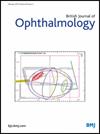Clinical factors predictive of tumour cytogenetics and metastasis in 86 patients with choroidal nevus growth into melanoma (DIP and DOT study)
IF 3.5
2区 医学
Q1 OPHTHALMOLOGY
引用次数: 0
Abstract
Background Choroidal melanoma can arise from malignant transformation of choroidal nevus. The Cancer Genome Atlas, a classification system based on the genetic status of chromosomes 3 and 8, can be used to prognosticate metastasis and death in choroidal melanoma. This study explores the impact that growth rates and clinical/imaging (TFSOM-DIM (To Find Small Ocular Melanoma, Doing IMaging)) risk factors have on cytogenetics, metastasis and death in choroidal nevus which transforms into melanoma. Methods A retrospective study was performed on 86 consecutive patients diagnosed with choroidal nevus with transformation into melanoma. Tumour cytogenetic results and TFSOM-DIM risk factors for transformation at the date of initial presentation (DIP) and date of transformation diagnosis (DOT) were recorded. Cytogenetic testing of tumours was offered to patients at DOT and was performed on tumour samples obtained via fine-needle aspiration biopsy prior to plaque radiotherapy initiation. Results Of 86 patients, 66% were cytogenetically low-risk and 34% were cytogenetically high-risk. At DOT, high-risk tumours possessed more TFSOM-DIM risk factors than low-risk tumours (4.5 vs 3.8, p=0.003). Choroidal nevus with growth in thickness >0.5 mm/year or >20% per year had increased risk for high-risk cytogenetics (relative risk (RR)=1.93, 95% CI 1.09 to 3.43, p=0.027; RR=2.18, 95% CI 1.22 to 3.92, p=0.008, respectively). Choroidal nevus with growth in basal diameter >0.7 mm/year or >10% per year had increased risk for high-risk cytogenetics (RR=2.22, 95% CI 1.25 to 3.93, p=0.007; RR=1.83, 95% CI 1.03 to 3.26, p=0.042, respectively). Conclusions When monitoring patients with choroidal nevus, clinical risk factors are important in estimating risk for transformation into melanoma. We found that thickness growth >0.5 mm/year or >20% per year, as well as basal diameter growth >0.7 mm/year or >10% per year, were all thresholds that demonstrated increased risk for high-risk cytogenetics. Additionally, tumours with a greater number of TFSOM-DIM risk factors by DOT had significantly increased likelihood of high-risk cytogenetics. No data are available.86例脉络膜痣生长为黑色素瘤的肿瘤细胞遗传学和转移的临床预测因素(DIP和DOT研究)
脉络膜黑色素瘤可由脉络膜痣的恶性转化引起。基于3号和8号染色体遗传状态的癌症基因组图谱分类系统可用于预测脉络膜黑色素瘤的转移和死亡。本研究探讨生长速率和临床/影像学(TFSOM-DIM, To Find Small Ocular Melanoma, Doing imaging)危险因素对脉络膜痣转化为黑色素瘤的细胞遗传学、转移和死亡的影响。方法对86例连续诊断为脉络膜痣转化为黑色素瘤的患者进行回顾性研究。记录肿瘤细胞遗传学结果和TFSOM-DIM转化的危险因素在初始表现(DIP)和转化诊断(DOT)的日期。肿瘤细胞遗传学检测提供给DOT患者,并在斑块放疗开始前通过细针穿刺活检获得肿瘤样本。结果86例患者中66%为细胞遗传学低危,34%为细胞遗传学高危。在DOT上,高危肿瘤比低危肿瘤具有更多的TFSOM-DIM危险因素(4.5 vs 3.8, p=0.003)。脉膜痣厚度增长为>0.5 mm/年或>20% /年的高危细胞遗传学风险增加(相对风险(RR)=1.93, 95% CI 1.09 ~ 3.43, p=0.027;RR=2.18, 95% CI 1.22 ~ 3.92, p=0.008)。脉络膜痣基底直径≥0.7 mm/年或≥10% /年的高危细胞遗传学风险增加(RR=2.22, 95% CI 1.25 ~ 3.93, p=0.007;RR=1.83, 95% CI 1.03 ~ 3.26, p=0.042)。结论在监测脉络膜痣患者时,临床危险因素是评估其转化为黑色素瘤风险的重要因素。我们发现,厚度增长>0.5 mm/年或>每年20%,以及基底直径增长>0.7 mm/年或>每年10%,都是表明高危细胞遗传学风险增加的阈值。此外,DOT检测的TFSOM-DIM危险因素数量较多的肿瘤,其高危细胞遗传学的可能性显著增加。无数据。
本文章由计算机程序翻译,如有差异,请以英文原文为准。
求助全文
约1分钟内获得全文
求助全文
来源期刊
CiteScore
10.30
自引率
2.40%
发文量
213
审稿时长
3-6 weeks
期刊介绍:
The British Journal of Ophthalmology (BJO) is an international peer-reviewed journal for ophthalmologists and visual science specialists. BJO publishes clinical investigations, clinical observations, and clinically relevant laboratory investigations related to ophthalmology. It also provides major reviews and also publishes manuscripts covering regional issues in a global context.

 求助内容:
求助内容: 应助结果提醒方式:
应助结果提醒方式:


